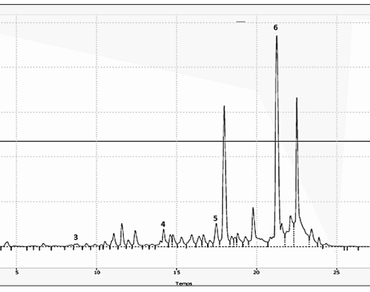Antiproliferative, anti-inflammatory, and antioxidant activity of aqueous extracts from Origanum compactum benth aerial part
Hamza El Finou, Mohamed Bammou, Hicham Mohti, Zaid Abdelhamid, Lhoussaine El Rhaffari
Research Articles | Published: 10 July, 2023
First Page: 1257
Last Page: 1263
Views: 3509
Keywords: Antiproliferative, Anti-inflammatory, n Origanum compactumn , Microglial macrophages, Nitric oxide
Abstract
Origanum compactum Benth (Lamiaceae), is an endemic plant of northern Morocco. rich in phenolic compounds that is commonly used in traditional Moroccan medicine to treat several diseases. Several studies have shown that Origanum compactum has bioactive properties, including, antioxidant, cytotoxic, and antitumor activity. In this study, the aqueous infusion of Origanum compactum leaves was tested to evaluate the antiproliferative effect against the skin cancer cells line A431 (epidermoid carcinoma). The anti-inflammatory effect was also evaluated by the nitric oxide (NO) and antioxidant assay. For this, we determined the ability of Origanum extracts to inhibit the NO production by the microglial macrophage cells (BV2) stimulated by LPS (Lipopolysaccharide). The extracts showed a significant antiproliferative effect by reducing the cell viability percentage to 20%. In addition, the Origanum compactum infusion has potent antioxidant effects as tested by the 2,2-diphenyl-1-picrylhydrazyl (DPPH) assay, with an IC50 of 38.04 ± 0.52 µg/mL and reducing power of 252.96 ± 4.32 mg AAE/g DM (expressed as Acid Ascorbic Equivalents) evaluated by ferric-reducing antioxidant power (FRAP) assay. Also, the extracts induced a significant (p < 0.001) reduction in NO production by LPS-activated BV2 cells to 5.52 µM/mL compared to 17.12 µM/mL for non-activated control cells. The results obtained in this study show that Origanum compactum has anti-inflammatory and anti-tumorigenic properties that support its use in traditional medicine.

References
Babili F, el Bouajila J, Souchard JP, Bertrand C, Bellvert F, Fouraste I, Moulis C, Valentin A (2011) Oregano: Chemical analysis and evaluation of its antimalarial, antioxidant, and cytotoxic activities. J Food Sci 76(3):C512–C518. https://doi.org/10.1111/j.1750-3841.2011.02109.x
Belkamel A, Bammi J, Belkamel A, Douira A (2013) Study of essential oil chemical composition of an endemic Ibero-moroccan: Origanum compactum (Benth). J Anim Plant Sci 19:2880–2887
Chaouki W, Leger DY, Eljastimi J, Beneytout JL, Hmamouchi M (2010) Antiproliferative effect of extracts from Aristolochia baetica and Origanum compactum on human breast cancer cell line MCF-7. Pharm Biol 48(3):269–274. https://doi.org/10.3109/13880200903096588
Chaouki W, Meddah B, Hmamouchi M (2015) Antiproliferative activity of Origanum compactum extract on lung cancer and hepatoma cells. Arab J Med Arom Plan 1(1):44–56
Chew YL, Goh JK, Lim YY (2009) Assessment of in vitro antioxidant capacity and polyphenolic composition of selected medicinal herbs from Leguminosae family in Peninsular Malaysia. Food chem 116(1):13–18. https://doi.org/10.1016/j.foodchem.2009.01.091
El Finou H, Salhi N, Halmoune A, El Rhaffari L (2023) Ethnobotanical Survey of Aromatic and Medicinal plants used in Traditional Medicine and Agri-Food in the Fez-Meknes Region. Biology Med Nat Prod Chem 12(1):133–141. https://doi.org/10.14421/biomedich.2023.121.133-141
Feng LS, Cheng JB, Su WQ, Li HZ, Xiao T, Chen DA, Zhang ZL (2022) Cinnamic acid hybrids as anticancer agents: a mini-review. Arch Pharm 355(7):2200052. https://doi.org/10.1002/ardp.202200052
Karmakar S, Roy Choudhury S, Banik N L, K Ray S (2011) Molecular mechanisms of anti-cancer action of garlic compounds in neuroblastoma. Anticancer Agents Med Chem 11(4):398–407. https://doi.org/10.2174/187152011795677553
Kar A (2007) Pharmacognosy and Pharmabiotechnologie, 2nd edn. New Age International Publishers, pp 1–30
Lee ATC, Azimahtol HLP, Tan AN (2003) Styrylpyrone Derivative (SPD) induces apoptosis in a caspase-7-dependent manner in the human breast cancer cell line MCF-7. Cancer Cell Int 3(16):1–8. https://doi.org/10.1186/1475-2867-3-16
Miceli N, Filocamo A, Ragusa S, Cacciola F, Dugo P, Mondello L, Taviano MF (2017) Chemical characterization and biological activities of phenolic-rich fraction from cauline leaves of Isatis tinctoria L. (Brassicaceae) growing in Sicily, Italy. Chem Biodivers 14(8):e1700073. https://doi.org/10.1002/cbdv.201700073
Oyaizu M (1986) Studies on products of browning reaction antioxidative activities of products of browning reaction prepared from glucosamine. Japanese J Nutrition dietetics 44(6):307–315. https://doi.org/10.5264/eiyogakuzashi.44.307
Park S (2013) The effects of high concentrations of vitamin C on cancer cells. Nutrients 5(9):3496–3505. https://doi.org/10.3390/nu5093496
Pisha E, Chai H, Lee IS, Chagwedera TE, arnsworth NR, Cordell GA, Beecher CW, Fong HH, Kinghorn AD, Brown DM et al (1995) Discovery of betulinic acid as a selective inhibitor of human melanoma that functions by induction of apoptosis. Nat Med 1(10):1046–1051. https://doi.org/10.1038/nm1095-1046
Ramdan B, Greche H, Nhiri M, Amakran A (2017) Anti-glycation and radical scavenging activities of hydro-alcohol and aqueous extracts of nine species from Lamiaceae family. J Med Plants Stud 5(1):331–345
Toyoda T, Tsukamoto T, Takasu S, Shi L, Hirano N, Ban H, Kumagai T, Tatematsu M (2009) Anti-inflammatory effects of caffeic acid phenethyl ester (CAPE), a nuclear factor-κB inhibitor, on Helicobacter pylori-induced gastritis in mongolian gerbils. Int J Cancer 125(8):1786–1795. https://doi.org/10.1002/ijc.24586
Youbi AEHE, Ouahidi I, Mansouri LE, Daoudi A, Bousta D (2016) Ethnopharmacological survey of plants used for immunological diseases in four regions of Morocco. Eur J Med Plants 13(1):1
https://doi.org/10.9734/ejmp/2016/12946
Zengin G, Bulut G, Mollica A, Picot-Allain CMN, Mahomoodally MF (2018) In vitro and in silico evaluation of Centaurea saligna (K. Koch) Wagenitz—An endemic folk medicinal plant. Comput bio chem 73:120–126. https://doi.org/10.1016/j.compbiolchem.2018.02.010
Author Information
Laboratory of Bioactives, Health, and Environment, Faculty of Sciences, Moulay Ismail University, Meknes, Morocco